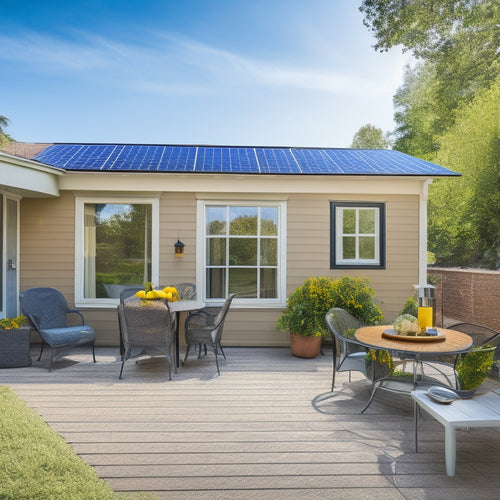
What Are the Installation Costs of a Home Solar Panel System
Share
When calculating the total installation cost of a home solar panel system, you'll need to take into account multiple components, including equipment, financing, incentives, and long-term savings. The overall cost can range from $12,500 to $70,000 or more, depending on the system size and quality of materials. You'll need to factor in the cost of solar panels, mounting hardware, inverters, and battery storage systems, as well as labor costs, permits, and inspection fees. Understanding these costs is vital to estimating your total investment and potential returns. As you investigate the details, you'll uncover how these components work together to impact your overall cost and energy savings.
Key Takeaways
- Overall installation costs include equipment, installation, financing, incentives, and long-term savings, with tax incentives reducing upfront costs by up to 26%.
- Solar panels account for 40-50% of total installation cost, with prices ranging from $2.50 to $3.50 per watt, depending on quality and brand.
- Labor costs typically range from $2,000 to $5,000, constituting 10-20% of total installation costs, and are influenced by installation challenges and complexity.
- Permits and inspections add $100 to $1,500 to the total cost, depending on jurisdiction and number of inspections required, ensuring compliance with local building codes.
- Additional costs for battery storage systems, advanced inverter technology, and smart monitoring systems can range from $5,000 to $15,000 or more, enhancing system performance and energy independence.
Understanding Solar Panel System Costs
When you're considering a home solar panel system, one of the most critical factors to evaluate is the cost. The overall cost of a solar panel system includes not only the equipment and installation expenses but also the financing options, incentives, and long-term savings.
You'll want to investigate financing options, such as loans or power purchase agreements, to find the best fit for your budget. Additionally, you'll benefit from tax incentives, like the Solar Investment Tax Credit, which can greatly reduce your upfront costs.
Solar leases are another option, allowing you to use the energy generated without owning the system. As you weigh your options, keep in mind that energy efficiency upgrades, like insulation and new windows, can further increase your system's effectiveness and savings.
Equipment and Material Expenses
You'll find that the largest portion of your equipment and material expenses comes from the solar panels themselves, which can range from $2.50 to $3.50 per watt, depending on the quality and brand.
Mounting hardware expenses, including racking and tracking systems, add to the overall cost, typically ranging from $0.10 to $0.30 per watt.
The inverter, which converts DC power to AC, typically falls within a price range of $0.10 to $0.25 per watt, depending on the type and quality of the unit.
Solar Panel Cost
How much do solar panels themselves contribute to the overall cost of a home solar panel system? They make up a significant portion, accounting for approximately 40% to 50% of the total installation cost.
The cost of solar panels varies based on factors such as efficiency, quality, and brand. High-efficiency panels with premium materials and warranties tend to be more expensive.
You can expect to pay between $2.50 and $3.50 per watt, with a typical residential solar panel system ranging from 5 to 20 kilowatts. This translates to a total cost of $12,500 to $70,000.
However, you may be eligible for solar incentives, such as the federal solar investment tax credit (ITC), which can reduce your expenses by up to 26%. Additionally, various financing options, like loans and power purchase agreements, can help make solar panels more affordable.
Mounting Hardware Expenses
Beyond the solar panels themselves, the mounting hardware expenses comprise a substantial portion of the overall installation cost, accounting for around 10% to 15% of the total.
As you evaluate your home solar panel system, you'll need to factor in the costs of the equipment and materials necessary to securely fasten the panels to your roof or install them on the ground.
The type of mounting technique you choose will greatly impact your costs. Roof-mounted systems typically require more installation materials, such as flashing, brackets, and clamps, which can drive up expenses.
On the other hand, ground-mounted systems often require more extensive excavation and concrete work, which can also be costly.
You'll also need to assess the quality and durability of the mounting hardware. High-quality materials can withstand harsh weather conditions and last for decades, but they come at a higher upfront cost.
Additionally, the complexity of your roof's design or the terrain of your land can also influence the mounting hardware expenses.
Inverter Price Range
With your solar panels securely mounted, the next essential component to assess is the inverter, which converts the DC power generated by the panels into AC power usable in your home. The inverter plays a critical role in ensuring your solar panel system operates efficiently and effectively.
When it comes to inverter pricing, you'll find a range of options to suit your budget and energy needs. Here are some key factors to evaluate:
-
Inverter efficiency: Look for inverters with high efficiency ratings (e.g., 98% or higher) to minimize energy losses.
-
Inverter lifespan: A longer inverter lifespan (e.g., 25 years or more) can reduce replacement costs and downtime.
-
String inverter vs. microinverter: String inverters are generally more cost-effective, while microinverters offer greater flexibility and monitoring capabilities.
-
Brand reputation and warranty: Reputable brands often offer longer warranties (e.g., 10-25 years) and better customer support.
-
Grid-tie inverter vs. off-grid inverter: Grid-tie inverters are suitable for systems connected to the grid, while off-grid inverters are designed for standalone systems.
Inverter prices vary widely, ranging from $0.10 to $0.30 per watt, depending on the specific model, features, and brand.
Labor Costs and Installation Fees
Your solar panel system installation is only as good as the team that puts it together, and that's where labor costs and installation fees come in. These costs vary depending on the complexity of your installation, the labor market conditions, and the installer's level of proficiency.
On average, labor costs range from $2,000 to $5,000, which is around 10% to 20% of the total installation cost.
You'll need to take into account installation challenges such as roof type, tree shading, and electrical panel upgrades, which can increase labor costs. A reputable installer will assess these challenges and provide a detailed quote for the installation.
Be wary of extremely low quotes, as they might indicate a lack of experience or a rushed job. A good installer will take the time to guarantee a high-quality installation that meets local building codes and safety standards.
When evaluating quotes, look for transparency and a clear breakdown of labor costs and installation fees. This will help you make an informed decision and guarantee a successful installation.
Permits and Inspection Charges
Several permits and inspections are required to confirm your solar panel system meets local building codes and safety standards.
These permits and inspections guarantee that your system is installed correctly and safely, and they're typically required by your local government.
You'll need to factor in the costs of these permits and inspections when budgeting for your solar panel system.
Here are some of the typical permit and inspection charges you can expect:
-
Permit application fees: These fees vary by jurisdiction, but you can expect to pay between $100 and $500 for a building permit.
-
Electrical permit fees: These fees are usually separate from building permit fees and can range from $50 to $200.
-
Inspection fees: You may need to pay for multiple inspections throughout the installation process, with costs ranging from $100 to $300 per inspection.
-
Plan review fees: These fees are typically charged by your local government to review your system's design and plans, and can range from $100 to $500.
-
Inspection timeline extensions: If your installation takes longer than expected, you may need to pay for additional inspection timeline extensions, which can cost $100 to $500.
Keep in mind that these costs can vary depending on your location and the complexity of your installation.
Inverter and Battery Costs
Now that you've accounted for permits and inspection charges, it's time to contemplate the equipment costs that will get your solar panel system up and running.
The inverter is a vital component that converts DC power from your solar panels to AC power for your home. Inverter efficiency is a significant factor in determining how much electricity you'll generate. Look for an inverter with high efficiency ratings (around 96-98%) to maximize your energy output. The cost of a high-quality inverter can range from $2,000 to $5,000, depending on the brand, model, and features.
If you're planning to store excess energy generated during the day for use at night or during power outages, you'll need a battery storage system.
Battery lifespan is an essential consideration, as it affects the overall cost and performance of your system. A high-quality battery with a long lifespan (around 10-15 years) can cost between $5,000 to $15,000 or more, depending on the type, capacity, and brand.
When calculating the inverter and battery costs, be sure to factor in the warranties, maintenance requirements, and potential upgrades or replacements down the line.
Additional System Upgrades
As you consider your home solar panel system, you may want to investigate additional upgrades to enhance its performance and functionality.
You'll have options to add energy storage solutions, advanced inverter technology, and smart monitoring systems, each of which can provide unique benefits and advantages.
These upgrades can increase your system's overall efficiency, reliability, and cost-effectiveness.
Energy Storage Options
Most homeowners who invest in a solar panel system contemplate energy storage options as a crucial additional system upgrade. This is because energy storage systems, such as batteries, enable you to store excess energy generated by your solar panels during the day for use during the night or during power outages.
This allows you to achieve greater energy independence and reduce your reliance on the grid.
When evaluating energy storage options, you should be aware of the following benefits and factors:
-
Sustainability benefits: Energy storage systems can help you reduce your carbon footprint and contribute to a cleaner environment.
-
Government incentives: You may be eligible for government incentives or rebates for installing energy storage systems.
-
Financing options: Many financing options are available to help you cover the cost of energy storage systems.
-
Maintenance requirements: Energy storage systems require regular maintenance to guarantee ideal performance and extend battery lifespan.
-
Grid connection: You'll need to assess how your energy storage system will connect to the grid and how it will be monitored for performance.
Advanced Inverter Technology
Your solar panel system's brain, the inverter, plays an essential role in converting DC power into usable AC power for your home.
Advanced inverter technology is an additional system upgrade that can greatly enhance your solar panel system's performance. One key benefit is improved inverter efficiency, which guarantees that more of the sun's energy is converted into usable power. This results in increased energy production and reduced energy losses.
Advanced inverters also enable seamless grid integration, allowing your system to synchronize with the grid's frequency and voltage. This feature is vital for feeding excess energy back into the grid and receiving credits from your utility company.
In addition, advanced inverters often come with built-in monitoring capabilities, enabling you to track your system's performance in real-time. By investing in advanced inverter technology, you can optimize your solar panel system's performance, increase energy production, and maximize your return on investment.
Smart Monitoring Systems
Through real-time monitoring and advanced data analytics, smart monitoring systems provide unparalleled understandings into your solar panel system's performance, enabling you to make data-driven decisions to optimize energy production and reduce downtime.
These systems allow you to track your energy production in real-time, identify potential issues, and receive alerts when performance drops.
Some key benefits of smart monitoring systems include:
-
Real-time analytics: Get instant observations into your system's performance and energy production.
-
Smart grid integration: Seamlessly connect with the grid and optimize energy distribution.
-
Customizable alerts: Receive notifications when performance drops or anomalies are detected.
-
Remote monitoring: Access your system's performance data from anywhere, at any time.
-
Data-driven decision making: Use actionable observations to optimize your system's performance and reduce energy waste.
With smart monitoring systems, you'll have complete visibility into your solar panel system's performance, enabling you to make informed decisions to maximize your energy savings and reduce your environmental footprint.
Frequently Asked Questions
Can I Install Solar Panels on a Metal or Asphalt Shingle Roof?
You can install solar panels on both metal and asphalt shingle roofs, but you'll need to take into account metal roof compatibility and asphalt shingle age/condition, as well as additional mounting requirements for metal roofs to guarantee a secure and watertight installation.
Do Solar Panels Work During Power Outages or Blackouts?
You're prepared for blackout chaos, wondering if solar panels keep your lights on during power outages. The answer is, they don't - unless you have a battery backup system, ensuring solar power reliability and blackout preparedness, giving you peace of mind when the grid goes dark.
How Long Does a Typical Solar Panel Installation Take?
You're wondering how long a typical solar panel installation takes. Typically, you're looking at a project duration of 3-5 days for a standard residential installation, with the installation timeline varying depending on the complexity of the project and the number of panels being installed.
Do Solar Panels Void My Roof's Warranty?
When you install solar panels, you're likely wondering if they'll void your roof's warranty. Fortunately, most manufacturers provide clear guidelines to avoid roof warranty implications, ensuring a smooth installation process that meets solar panel installation guidelines, giving you peace of mind.
Can I Install Solar Panels Myself to Save Money?
Sparkling savings seem sweet, but scrutinize DIY considerations carefully; while you'll avoid labor costs, you'll still need to invest in equipment, permits, and potential roofing repairs, which might offset your anticipated cost savings.
Conclusion
As you flip the switch on your new solar panel system, the meter starts running backwards, and you can't help but think about the dollars adding up in your favor. Coincidentally, the sun shines brighter, as if celebrating your decision to go green. The installation costs may have seemed intimidating, but now they're a distant memory, replaced by the joy of utilizing free energy. With your system up and running, you're one step closer to energy independence, and a more sustainable future.
Related Posts
-

10 Essential Bike Lane Safety Features to Consider
You're designing a bike lane with safety in mind, and that's essential. The National Highway Traffic Safety Administr...
-

10 Tips to Buy Affordable Solar Panels Online
When purchasing affordable solar panels online, you'll want to research reputable retailers, compare prices, and chec...
-

Planning for an Electric Vehicle-Friendly Urban Future
As you plan for an electric vehicle-friendly urban future, you'll need to integrate high-power charging stations, sma...


